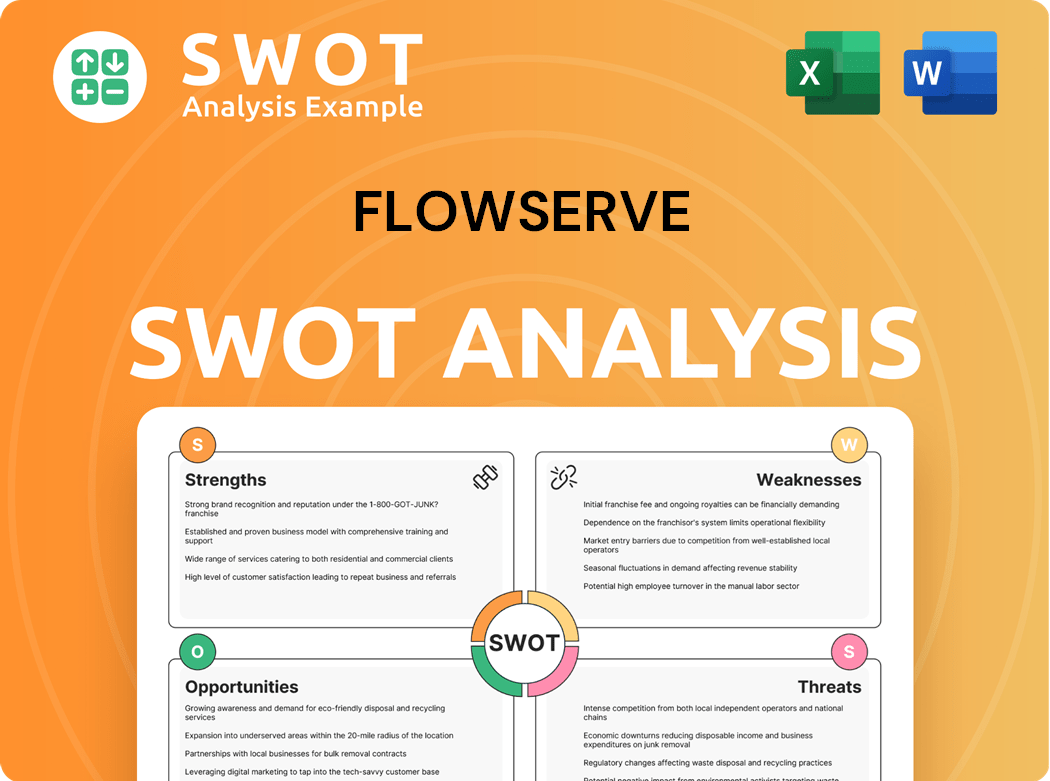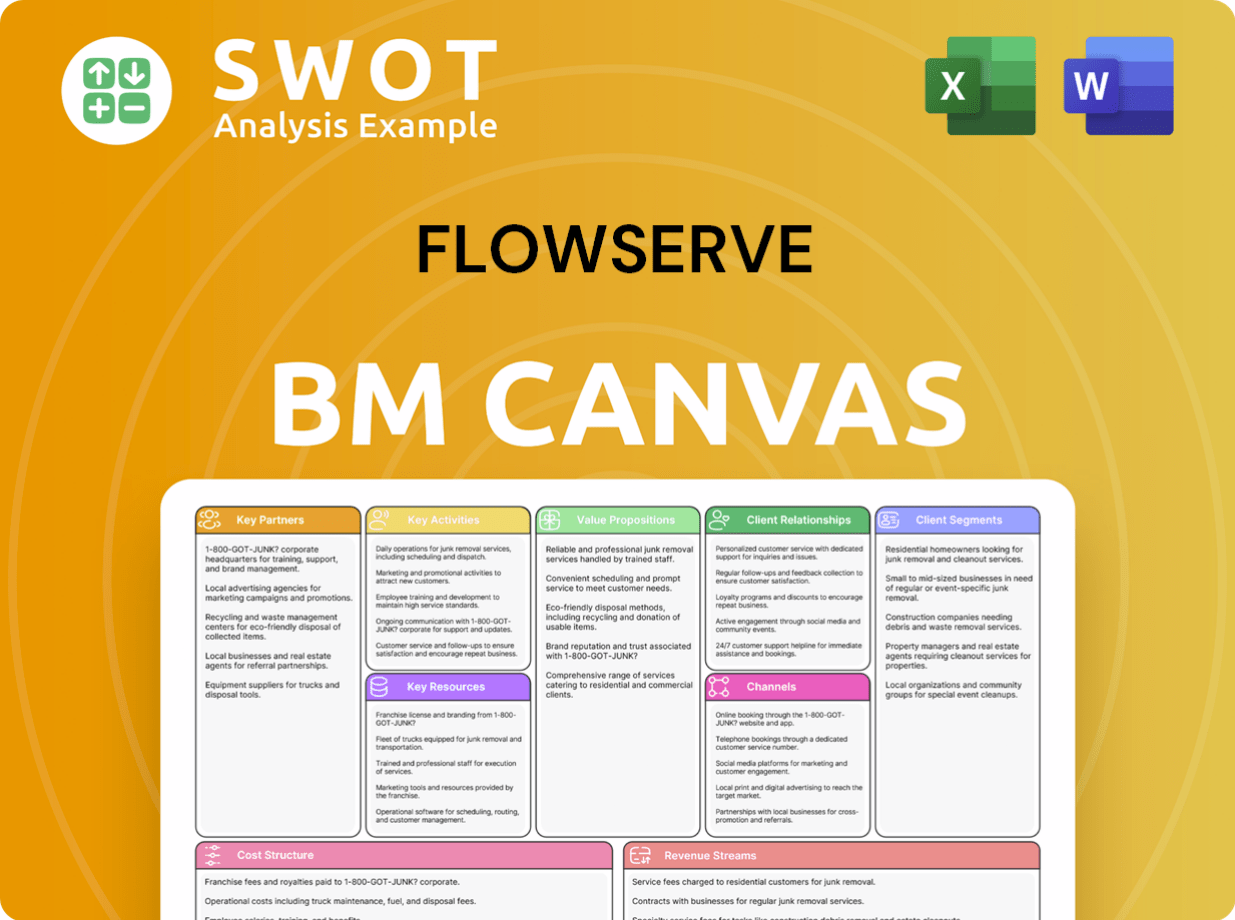Flowserve Bundle
Who Really Controls Flowserve Corporation?
Unraveling the Flowserve SWOT Analysis is just the start; understanding its ownership is key to grasping its future. Knowing who owns Flowserve offers crucial insights into the strategic decisions that shape this global leader in fluid motion and control. This deep dive explores the very foundation of Flowserve, examining its ownership structure and the forces that drive its success.

From its inception in 1997 through the merger of Durco International and BW/IP International, to its current status as a publicly traded entity, Flowserve's ownership has evolved significantly. The Flowserve ownership structure, comprised of institutional investors, mutual funds, and individual shareholders, reveals much about the company's governance and long-term goals. Understanding the Flowserve company profile is essential for investors.
Who Founded Flowserve?
The story of Flowserve begins with a merger, not a traditional founding. The company emerged in 1997 from the union of Durco International and BW/IP International. This means there aren't individual 'founders' in the typical sense; instead, the early ownership was a combination of the shareholders from these two pre-existing entities.
Understanding the early ownership structure of the Flowserve company requires looking at the legacy of Durco International and BW/IP International. Details on the exact equity splits or initial shareholding percentages of the original stakeholders of these companies aren't readily available in public records, given their long operational histories before the merger. The merger effectively created a new public entity.
Following the merger, the ownership of the Flowserve corporation was distributed among the shareholders of both Durco International and BW/IP International, according to the merger agreement. This resulted in a dispersed ownership structure from the outset, with shares held by a multitude of investors who had previously held shares in the predecessor companies. The initial ownership was institutional and public, not involving angel investors or friends and family in the typical startup model.
The early ownership of Flowserve was dispersed among the shareholders of Durco International and BW/IP International.
The merger agreement outlined the terms for share exchanges and the formation of the new corporate entity.
The merger created a new public entity, meaning initial ownership was broadly distributed.
Unlike startups, Flowserve didn't have individual founders, but rather emerged from a corporate merger.
The post-merger vision was to become a leading global provider in fluid motion and control products.
Initial ownership was primarily institutional and public in nature.
The formation of Flowserve through the merger of Durco International and BW/IP International shaped its early ownership structure. This involved the consolidation of existing shareholders, resulting in a public entity with dispersed ownership. The merger agreement governed share exchanges, and the vision was to create a global leader in fluid motion and control products. Understanding the early ownership is crucial for grasping the company's historical development and the influence of its initial stakeholders. The company's structure reflects the merger of two established entities, not a typical startup with individual founders or angel investors. The company's headquarters are located in Irving, Texas. As of December 31, 2023, the company had approximately 17,000 employees. The company's stock is traded on the New York Stock Exchange under the ticker symbol FLS.
- Merger of Durco and BW/IP.
- Shareholders from both companies.
- Publicly traded from inception.
- No individual founders.
- Institutional and public ownership.
Flowserve SWOT Analysis
- Complete SWOT Breakdown
- Fully Customizable
- Editable in Excel & Word
- Professional Formatting
- Investor-Ready Format

How Has Flowserve’s Ownership Changed Over Time?
The evolution of Flowserve's ownership began in 1997 with the merger of Durco International and BW/IP International, leading to its formation as a publicly traded entity. The initial market capitalization reflected the combined valuation of these companies. Since then, the Flowserve ownership structure has primarily comprised institutional investors, mutual funds, and index funds, a common characteristic of large-cap public companies.
The Flowserve company has seen its ownership evolve over time, with shifts primarily driven by market dynamics and investment strategies of the major institutional holders. These changes, influenced by market performance and fund activities, reflect the passive investment approach typically adopted by these large firms. This structure generally supports stable governance, as these investors are focused on long-term value creation and engage with management on corporate governance issues. For more insights, consider exploring the Marketing Strategy of Flowserve.
| Shareholder | Percentage of Shares (as of March 31, 2024) | Type |
|---|---|---|
| Vanguard Group Inc. | 12.06% | Institutional |
| BlackRock Inc. | 10.64% | Institutional |
| State Street Corp. | 5.09% | Institutional |
| J.P. Morgan Investment Management Inc. | Not Specified | Institutional |
| Geode Capital Management, LLC | Not Specified | Institutional |
As of early 2025, the Flowserve investors landscape is dominated by large institutional stakeholders. Vanguard Group Inc. and BlackRock Inc. hold significant positions, with approximately 12.06% and 10.64% of shares respectively, as of March 31, 2024. State Street Corp. also maintains a considerable stake, holding about 5.09%. Other key institutional holders include J.P. Morgan Investment Management Inc. and Geode Capital Management, LLC. These major shareholders reflect a focus on long-term value and engagement in corporate governance.
Flowserve corporation's ownership structure is primarily composed of institutional investors. Major shareholders include Vanguard and BlackRock. These investors generally promote stable governance through a focus on long-term value.
- Institutional investors hold the majority of Flowserve stock.
- Ownership changes are mainly due to market performance and fund activities.
- No significant individual shareholders control the company.
- The ownership structure supports long-term value creation.
Flowserve PESTLE Analysis
- Covers All 6 PESTLE Categories
- No Research Needed – Save Hours of Work
- Built by Experts, Trusted by Consultants
- Instant Download, Ready to Use
- 100% Editable, Fully Customizable

Who Sits on Flowserve’s Board?
As of early 2025, the Board of Directors of the Flowserve Corporation includes a mix of independent directors and company executives. This structure aims to ensure robust corporate governance. The board members are elected by the shareholders, and their varied expertise supports strategic decision-making within the company. While specific individuals representing major shareholders aren't typically identified on the board in a public company like Flowserve, the interests of institutional investors are generally represented through the oversight function of the independent directors.
The board's primary responsibilities include overseeing management, approving strategic plans, and ensuring accountability to shareholders. Decisions are made through a majority vote of the directors. This structure helps maintain a balance between management's operational focus and shareholder interests. The composition of the board reflects a commitment to sound corporate governance practices, which is crucial for maintaining investor confidence and ensuring the long-term success of the company.
| Board Member | Role | Affiliation |
|---|---|---|
| Scott Rowe | President and CEO | Flowserve Corporation |
| Robert A. Baker | Independent Director | Retired Executive |
| Linda K. Baddour | Independent Director | Retired Executive |
The voting structure for Flowserve follows the one-share-one-vote principle, common in the U.S. This means each share of common stock grants one vote on shareholder matters, such as director elections and executive compensation. There are no indications of special voting rights or shares that would grant outsized control. This ensures that voting power is directly proportional to the equity stake held. For more information about the company's position in the market, you can read about the Competitors Landscape of Flowserve.
Flowserve's ownership is primarily held by institutional investors and the public. The company is publicly traded, meaning anyone can buy Flowserve stock. The board is responsible for overseeing management and ensuring accountability to shareholders.
- Institutional investors hold a significant portion of the shares.
- Individual investors also own shares through the stock market.
- The company's leadership team, including the CEO, also holds shares.
- The one-share-one-vote structure ensures fair voting rights.
Flowserve Business Model Canvas
- Complete 9-Block Business Model Canvas
- Effortlessly Communicate Your Business Strategy
- Investor-Ready BMC Format
- 100% Editable and Customizable
- Clear and Structured Layout

What Recent Changes Have Shaped Flowserve’s Ownership Landscape?
Over the last few years, the ownership of the Flowserve Corporation has largely remained consistent. It's primarily a publicly traded company, with institutional investors holding a significant portion of the shares. There haven't been any major shifts like substantial share buybacks or significant mergers and acquisitions that have drastically altered the ownership structure. However, there's a continuous trend of slight increases or decreases in holdings by major institutional investors.
For instance, while companies like Vanguard and BlackRock are among the top holders, their exact percentage ownership can fluctuate due to market changes and internal fund adjustments. This is a common pattern for companies of Flowserve's size and maturity. The ownership structure often sees a rise in institutional ownership, especially with the growth of passive investment vehicles like index funds. This can lead to a more dispersed ownership base, where no single entity holds a controlling stake, which often focuses on overall market performance and ESG (Environmental, Social, and Governance) factors.
| Shareholder | Approximate Ownership (as of late 2024) | Notes |
|---|---|---|
| Vanguard Group | Around 9-11% | One of the largest institutional holders. |
| BlackRock | Around 7-9% | Another major institutional investor. |
| Institutional Investors (Other) | Around 50-60% | Combined holdings of various other institutional investors. |
The industrial pumps and valves sector could see ownership changes if Flowserve engages in significant M&A activity, but no such major events have been recently reported that would fundamentally alter its current ownership structure. The rise of activist investors is a general trend in the market, but Flowserve has not been a prominent target of such campaigns in recent years, suggesting a relatively stable ownership and governance environment.
Flowserve's ownership structure has remained relatively stable. Institutional investors continue to hold a significant portion of the shares. There haven't been any major ownership changes over the past few years.
Vanguard and BlackRock are among the top institutional holders. Their exact ownership percentages fluctuate based on market conditions. Institutional ownership is a significant aspect of Flowserve's ownership profile.
The trend is toward increased institutional ownership. Passive investment vehicles contribute to a more dispersed ownership base. Flowserve focuses on broad market performance and ESG factors.
Flowserve is expected to continue operating as a publicly traded entity. The company's ownership base is dominated by institutional investors. There are no immediate plans for significant changes.
Flowserve Porter's Five Forces Analysis
- Covers All 5 Competitive Forces in Detail
- Structured for Consultants, Students, and Founders
- 100% Editable in Microsoft Word & Excel
- Instant Digital Download – Use Immediately
- Compatible with Mac & PC – Fully Unlocked

Related Blogs
- What are Mission Vision & Core Values of Flowserve Company?
- What is Competitive Landscape of Flowserve Company?
- What is Growth Strategy and Future Prospects of Flowserve Company?
- How Does Flowserve Company Work?
- What is Sales and Marketing Strategy of Flowserve Company?
- What is Brief History of Flowserve Company?
- What is Customer Demographics and Target Market of Flowserve Company?
Disclaimer
All information, articles, and product details provided on this website are for general informational and educational purposes only. We do not claim any ownership over, nor do we intend to infringe upon, any trademarks, copyrights, logos, brand names, or other intellectual property mentioned or depicted on this site. Such intellectual property remains the property of its respective owners, and any references here are made solely for identification or informational purposes, without implying any affiliation, endorsement, or partnership.
We make no representations or warranties, express or implied, regarding the accuracy, completeness, or suitability of any content or products presented. Nothing on this website should be construed as legal, tax, investment, financial, medical, or other professional advice. In addition, no part of this site—including articles or product references—constitutes a solicitation, recommendation, endorsement, advertisement, or offer to buy or sell any securities, franchises, or other financial instruments, particularly in jurisdictions where such activity would be unlawful.
All content is of a general nature and may not address the specific circumstances of any individual or entity. It is not a substitute for professional advice or services. Any actions you take based on the information provided here are strictly at your own risk. You accept full responsibility for any decisions or outcomes arising from your use of this website and agree to release us from any liability in connection with your use of, or reliance upon, the content or products found herein.